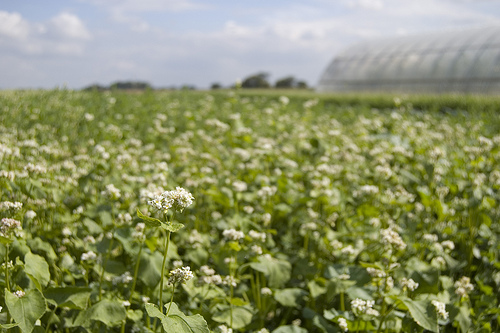Production
Sustainable Practices
Cover Crops
Laura and Adam use cover crops to control weeds, reduce erosion, build soil, and manage fertility. Some of their preferred cover crop species are hairy vetch, buckwheat (Figure 42), clover, oats, winter rye, ryegrass, and field peas. Eventually they hope to use chickens in some cover-cropped fields to help build fertility. Seeds are typically broadcast with a hand-broadcaster and then incorporated with a disc or drag. |
 Figure 42: Buckwheat was planted as a cover crop in the unused portion of a field of spring greens. The fast-growing nature of buckwheat makes it good for weed suppression. It also provides pollinator habitat. This cover crop stayed in place until October, when it was incorporated into the soil with a disc. |
Most years, Adam and Laura grow at least one cover crop on each field. Fields are typically seeded in the fall to an overwintered legume, such as vetch, and the cover crop is incorporated the following spring just before it blossoms in order to capture as much nitrogen in the soil as possible. They also utilize cover crops between the time when early crops are harvested and late crops are planted and during non-vegetable production years. Cover crop selection in resting years depends on weed pressure, previous crop history, and the fertility needs of a given field.
Cover crops are also integrated with vegetable production. Fields of fall crops may be undersown with clover, vetch, or rye to build fertility for the next spring while still producing cash crops. For cover crops integrated with crop production, the timing and type of cover crops depend in part on whether a field is used for production until late fall (e.g., for fall broccoli and cauliflower) or is needed for very early spring planting (as is the case for onions and early potatoes). In some cases, the fall crop itself leaves enough residue to act as “cover” over the winter, thereby minimizing erosion and allowing for continual addition of organic matter to the soil.
| Farmer’s Perspective: On the Bookshelf Managing Cover Crops Profitably, 3rd Edition By SARE Revised and updated in 2007, the 3rd edition includes a new chapter on brassicas and mustards, 16 farm profiles, and a comprehensive chapter on the use of cover crops in conservation tillage systems. Appendices include seed sources and a listing of cover crop experts. Steel in the Field: A Farmer’s Guide to Weed Management ToolsBy Sustainable Agriculture Network/Edited by Greg Bowman This SARE publication shows how today's implements and techniques can control weeds while reducing - or eliminating - herbicides. In practical language, it presents what farmers and researchers have learned in the last 20 years about cutting weed-control costs through improved cultivation tools, cover crops, and new cropping rotations. |